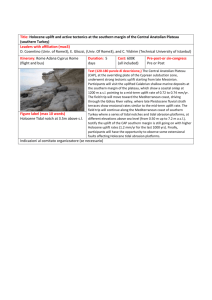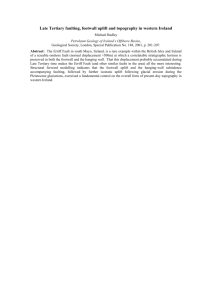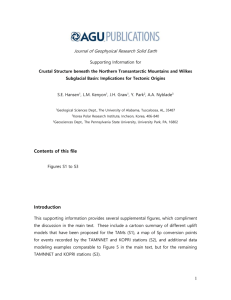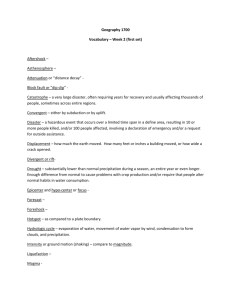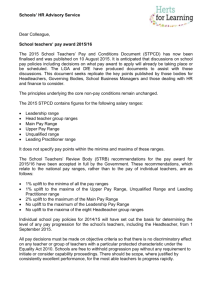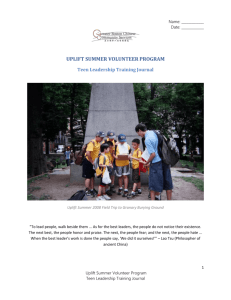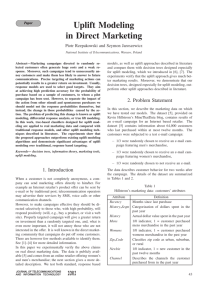About the Uplift Universe
advertisement
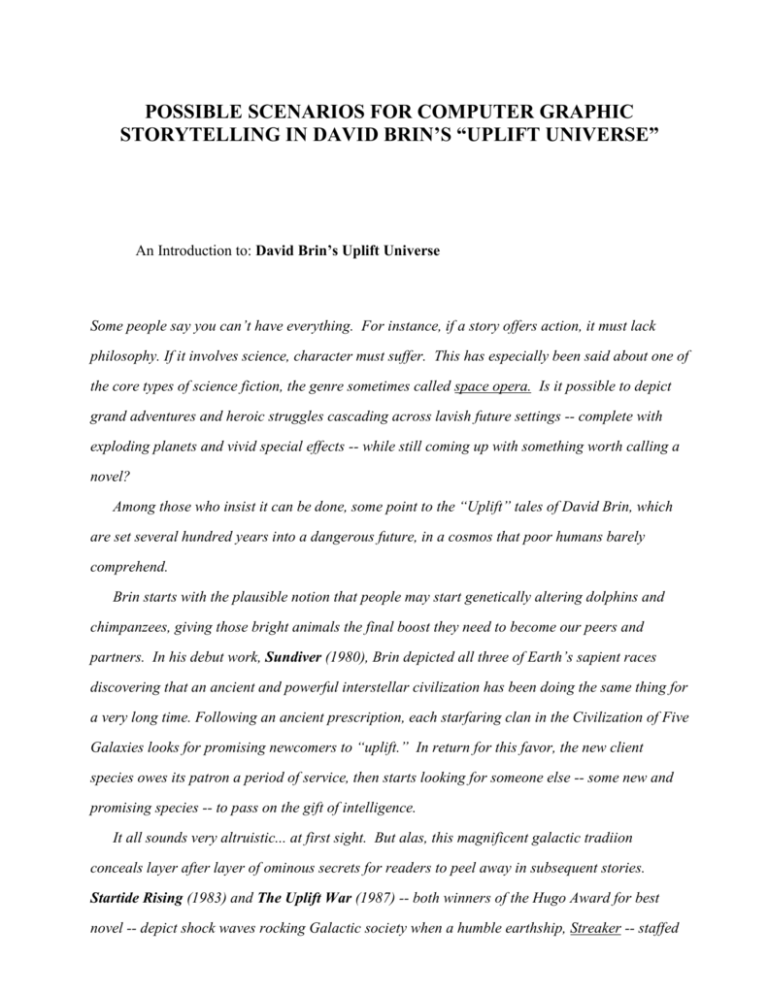
POSSIBLE SCENARIOS FOR COMPUTER GRAPHIC STORYTELLING IN DAVID BRIN’S “UPLIFT UNIVERSE” An Introduction to: David Brin’s Uplift Universe Some people say you can’t have everything. For instance, if a story offers action, it must lack philosophy. If it involves science, character must suffer. This has especially been said about one of the core types of science fiction, the genre sometimes called space opera. Is it possible to depict grand adventures and heroic struggles cascading across lavish future settings -- complete with exploding planets and vivid special effects -- while still coming up with something worth calling a novel? Among those who insist it can be done, some point to the “Uplift” tales of David Brin, which are set several hundred years into a dangerous future, in a cosmos that poor humans barely comprehend. Brin starts with the plausible notion that people may start genetically altering dolphins and chimpanzees, giving those bright animals the final boost they need to become our peers and partners. In his debut work, Sundiver (1980), Brin depicted all three of Earth’s sapient races discovering that an ancient and powerful interstellar civilization has been doing the same thing for a very long time. Following an ancient prescription, each starfaring clan in the Civilization of Five Galaxies looks for promising newcomers to “uplift.” In return for this favor, the new client species owes its patron a period of service, then starts looking for someone else -- some new and promising species -- to pass on the gift of intelligence. It all sounds very altruistic... at first sight. But alas, this magnificent galactic tradiion conceals layer after layer of ominous secrets for readers to peel away in subsequent stories. Startide Rising (1983) and The Uplift War (1987) -- both winners of the Hugo Award for best novel -- depict shock waves rocking Galactic society when a humble earthship, Streaker -- staffed by a hundred neo-dolphins and a few human beings -- tumbles across clues to a billion-year old conspiracy. The uplift universe is rich in elements that sci-fi lovers enjoy -- for instance, where most authors would use just one way to surpass the velocity of light, Brin throws in half a dozen inventive methods to cheat Einstein’s speed limit. For a lavish stage, he uses not one but five galaxies, with more waiting on the wings. Yet it is the characters -- especially dolphins, chimps and a wide range of fascinating aliens -that give this series its most memorable ideas and sympathetic moments. After a hiatus of several years to work on other projects, Brin returned to this broad canvas with the new Uplift Storm Trilogy, consisting of three connected novels -- Brightness Reef (1995), Infinity’s Shore (1996), and Heaven's Reach (1998). These works continue exploring the adventures and trials of the Streaker crew, but also delve into a unique, multi-racial society on Jijo, an isolated planet that was declared “fallow,” or off-limits to sapient beings in order to let its biosphere recover. Despite this well-intended law, a series of “sneakships” have come to this forbidden world, bringing illegal colonists from half a dozen races, each with desperate reasons to flee growing danger back home. After initial struggles and misunderstandings, the Six Races of Jijo -- including exile humans -- made peace, joining to create a decent shared culture while hiding from the cosmos... until one day all their troubles come crashing in on them from above. David Brin explains some of the thinking underlying this imaginative science fictional series. About the Uplift Universe I seldom write two space-oriented "universe" books in a row. There are so many possible settings and situations for stories, and I like especially to alternate with more ‘grownup’ novels, set on Earth in near-plausible futures. Still, my Uplift Series of far future space tales proved popular enough to draw me into a recent trilogy -- Brightness Reef, Infinity’s Shore, and Heaven’s Reach. Added to three earlier novels -- Sundiver, Startide Rising, and The Uplift War -- they form a cluster of adventures in the unabashedly proud space-opera tradition, with some ideas mixed in amid all the dash and sci-fi élan. First of all, the Uplift Universe is not "hard" science fiction. True, I am known as a hard SF writer, who often uses plausible science in his stories. And there is a lot of imaginative scientific speculation in books like Sundiver. Still, it would be a stretch to call any of the Uplift books "plausible! In fact, I kind of satirize the genre by having not one, not two but dozens of ways to cheat the speed of light barrier! These books aren’t essentially about that stuff. At one level, this series works deal with the moral, scientific and emotional implications of “uplift” -- the genetic engineering of other animals to bring them into our civilization with humanequivalent powers of thought. Many other authors (e.g. H.G. Wells, Pierre Boule, Mary Shelley, and Cordwainer Smith) dealt with this general concept before, but they all approached it in nearly the same way, by assuming the process would be abused -- that the humans bestowing this boon would be mad, and spoil things by establishing a cruel slave-master relationship with their creations. Now of course that is one possible (and despicable) outcome. Those were good stories with wholesome moral messages. But that vein is overworked, so I chose a different tack. What if we someday begin modifying higher animals -- and I think we clearly will -- guided by the morality of modern liberal society? Filled with stylish hyper-tolerance and guilt-ridden angst, would we be in danger of killing our clients with kindness? More important, these new kinds of sapient beings would face real problems, even if they are treated well. Adjustment would be hard. One needn’t picture slavery in order to sympathize with their plight. Pondering the notion of Uplift, it occurred to me how obvious the process might seem to alien beings who have travelled the stars for eons, encountering countless pre-sapient life forms and giving each one a boost, creating new generations of starfarers who would then do the same for others, and so on. The resulting image of a galaxy-spanning culture enthralled me. It would have great advantages, but perhaps also lead to a kind of stultified cultural conservatism. An obsession with the past. Now suppose a rambunctious young clan of Earthlings -- humans, uplifted dolphins and chimps -- encountered such a vast, ancient civilization. How would the newcomers be treated? How would we upstarts react? Too many science fictional scenarios assume states of unexplained disequilibrium, in which exploring humans just happen to emerge at exactly the right time to bump into others out there, who have exactly the right level of social and technological development to be interesting competitors or allies. In fact, the normal state affairs will be one of equilibrium... an equilibrium of law perhaps, or an equilibrium of death. We may be the First Race, as I discuss in my story, my short story "The Crystal Spheres," or else late arrivals, as depicted in the Uplift books. Either way, we're unlikely to meet aliens as equals. My second motivation in this series was ecological. What we're doing to our Earth makes me fear there may have already been "brush fire" ecological holocausts across the galaxy. The common science fictional scenario depicts eager settlers shouting “let's go fill the universe!” This wild frontier image is very satisfying, but thoughtless expansion might leave behind eco-wastelands within only a few generations -- as we are now seeing in many parts of the fragile Earth. Suppose the same kind ot already happened in interstellar space, spreading across the galaxy in a brush fire of shortsighted exploitation. It could help explain the apparent emptiness that scientists now observe, in which the Universe seems to have few, if any, other voices. Of course such a pattern of self-defeating destruction might be avoided. Suppose something regulated the way colonists treat planets, forcing them to consider the long term. The Uplift Universe illustrates one way it might happen. For all of their inscrutability, and occasional nastiness, my Galactics assign a high priority to preserving planets, habitats, and nature’s potential for creating new sapient life. The result is a noisy, bickering universe, but one filled with much more diversity than there otherwise might have been. Of course, much of the fun has been trying to get into the heads of “neo” dolphin or chimp characters. The Uplift concept makes this a nifty authorial exercise. When characters seem just a bit too human, that is a result (naturally) of both the genetic and cultural measures that were taken to make them members of Earth culture. But from that safe ground I’ve enjoyed exploring outward, harkening to older and more natural cetacean and simian instincts, both ennobling ones and those that might embarrass a proud sapient being... the way ghosts of ancient pre-humanity sometimes trouble men and women in the modern era. In neo-dolphins, especially, I tried to combine the latest scientific facts and models of cetacean cognition with my own imaginative extrapolations of their ‘cultural’ and emotional life.

